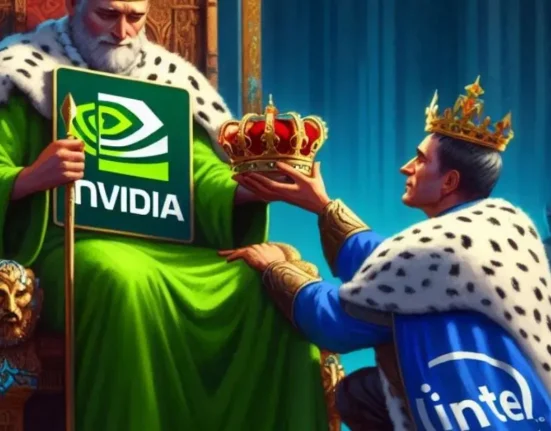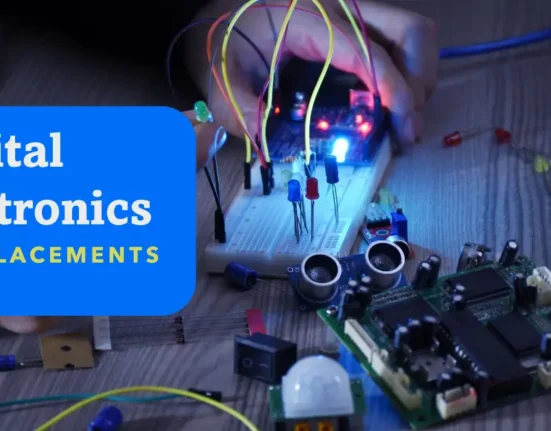Nvidia Considering To Acquire Intel ?
Nvidia’s potential acquisition of Intel is a hot topic that’s generating a lot of buzz in the tech community. Nvidia, renowned for its graphics processing units (GPUs), and Intel, a titan in central processing units (CPUs), are both giants in the semiconductor industry. The implications of such a deal could be far-reaching, reshaping market dynamics, technological advancements, and competitive positioning.
Table of Contents
ToggleBackground of Nvidia and Intel
Nvidia, founded in 1993, has established itself as a leader in GPUs, crucial for gaming, professional visualization, data centers, and artificial intelligence (AI). Its innovations have propelled advancements in autonomous vehicles, robotics, and high-performance computing. Intel, on the other hand, has been a cornerstone of semiconductor technology since its founding in 1968. Known for its x86 microprocessors, Intel has dominated the PC and server markets and has been expanding into AI, 5G, and edge computing.
Why is Nvidia Considering To Acquire Intel ?
So, why is Nvidia eyeing Intel? The strategic reasons are multifaceted. Combining Nvidia’s GPU prowess with Intel’s CPU dominance could create a powerhouse capable of delivering comprehensive computing solutions. This Nvidia Intel merger would allow Nvidia to diversify its product offerings and strengthen its competitive edge against rivals like AMD and Qualcomm.
Financially, if Nvidia acquires Intel , it would give Nvidia access to Intel’s extensive intellectual property and manufacturing capabilities. Intel’s advancements in semiconductor fabrication and robust supply chain infrastructure could significantly enhance Nvidia’s production capabilities, driving greater efficiency and innovation.
Moreover, this acquisition would position Nvidia to better compete in emerging markets such as AI, 5G, and autonomous vehicles. Integrating Nvidia’s AI technologies with Intel’s data processing capabilities could accelerate the development of next-generation technologies, driving substantial growth and market expansion.
Also Read: Meet The startup behind Intel’s Flagship Gaudi Processors
The Financial Aspects of the Nvidia’s Intel Acquisition
Financially, this Nvidia’s Intel acquisition is monumental. The estimated Nvidia’s Intel acquisition cost could reach hundreds of billions of dollars, making it one of the largest deals in tech history. Nvidia’s strong financial performance, characterized by significant revenue growth and market capitalization, places it in a favorable position for such an investment.
Intel, despite recent challenges, remains financially robust with a diverse portfolio and steady revenue streams. The acquisition would require Nvidia to leverage a combination of cash reserves, stock, and potentially debt financing. Analysts predict that the financial synergy created by this merger could enhance shareholder value and drive long-term profitability for Nvidia.
Benefits of the Intel Nvidia Merger.
The potential benefits of Nvidia acquiring Intel are substantial. Technologically, the merger could lead to the development of cutting-edge products that integrate the best of both companies’ innovations. Nvidia’s AI and GPU technology, combined with Intel’s CPU and semiconductor manufacturing expertise, could result in superior computing solutions that advance multiple industries.
From a market perspective, the acquisition would significantly expand Nvidia’s footprint. By incorporating Intel’s customer base and market channels, Nvidia could enhance its global reach and market penetration, better competing against other semiconductor giants and consolidating its leadership position in the industry.
Furthermore, the acquisition could drive cost efficiencies through economies of scale. By streamlining operations and optimizing resource utilization, Nvidia could achieve greater operational efficiency, reducing costs and improving profit margins.
Also Read : A world without Nvidia , how it would have been?
Challenges and Risks of Nvidia acquiring Intel.
Despite the potential benefits, this acquisition isn’t without its challenges and risks. One primary hurdle is regulatory approval. Given the size and influence of both companies, the deal would likely face intense scrutiny from antitrust authorities worldwide. Regulators may express concerns about reduced competition and potential monopolistic behavior, posing a significant obstacle to the merger.
Integration challenges also loom large. Merging two tech giants with distinct corporate cultures, operational structures, and product lines can be complex and arduous. Ensuring a seamless integration while maintaining productivity and innovation will be crucial to the success of the acquisition.
Additionally, the financial burden of such a massive acquisition could strain Nvidia’s resources. While the company is financially robust, the sheer scale of the investment required may impact its financial flexibility and ability to pursue other strategic initiatives.
Impact on the Semiconductor Industry
The potential acquisition of Intel by Nvidia would undoubtedly have a profound impact on the semiconductor industry. It would likely trigger a wave of consolidations as other companies seek to strengthen their positions in response. The merger could alter the competitive landscape, leading to increased competition and innovation as firms strive to keep up with the new powerhouse.
This acquisition could also accelerate the development of new technologies. With combined resources and expertise, Nvidia and Intel could drive advancements in AI, 5G, and other emerging fields. This would benefit not only the companies involved but also the broader tech industry and consumers who stand to gain from these innovations.
However, smaller companies in the semiconductor industry might face increased pressure to innovate or risk being left behind. The merger could create an environment where only the largest and most well-resourced firms can compete effectively.
How This Acquisition Could Shape the Future of AI and Computing ?
The integration of Nvidia’s AI capabilities with Intel’s computing power could have far-reaching implications for the future of AI and computing. By combining their strengths, Nvidia and Intel could develop more powerful and efficient AI systems, driving advancements in various sectors, including healthcare, automotive, and finance.
For instance, the merger could lead to the creation of AI-driven diagnostic tools that can analyze medical images with unprecedented accuracy. In the automotive industry, enhanced AI systems could improve the safety and reliability of autonomous vehicles. Financial institutions could benefit from more sophisticated AI algorithms for fraud detection and risk management.
Moreover, the acquisition could enable the development of more energy-efficient computing solutions. By leveraging Intel’s manufacturing capabilities, Nvidia could produce GPUs and CPUs that deliver higher performance with lower power consumption, contributing to more sustainable technology solutions.
Possible Outcomes if the Acquisition Fails
If the acquisition fails to materialize, Nvidia and Intel will need to reassess their strategic plans. Nvidia might explore other acquisition opportunities or focus on organic growth through innovation and expansion into new markets. Intel, on the other hand, would need to address its current challenges and find ways to regain its competitive edge independently.
For Nvidia, failure to acquire Intel could mean missing out on the potential synergies and technological advancements that the merger could bring. However, Nvidia’s strong market position and innovative capabilities would still provide a solid foundation for future growth.
For Intel, the failure of the acquisition could lead to increased pressure to innovate and compete more effectively in the rapidly evolving tech landscape. The company would need to leverage its strengths and explore new avenues for growth to remain relevant and competitive.
The Role of Government and Regulation in Nvidia Intel Merger.
Regulatory approval is a significant hurdle for the Nvidia-Intel acquisition. Antitrust authorities worldwide would scrutinize the deal to ensure it doesn’t stifle competition or create a monopoly in the semiconductor industry. Regulatory bodies would assess the potential impact on consumers, competitors, and the overall market dynamics.
Governments might also weigh in on the strategic importance of the semiconductor industry. Given the critical role semiconductors play in national security and technological advancement, regulatory approval could involve geopolitical considerations.
The regulatory process could be lengthy and complex, with the possibility of conditions or requirements being imposed on the merger to address competition concerns. Both Nvidia and Intel would need to navigate these regulatory challenges carefully to secure approval and move forward with the acquisition.
Historical Context of Major Tech Acquisitions
Major tech acquisitions have historically shaped the industry landscape, and the Nvidia-Intel deal would be no exception. Past acquisitions, such as Facebook’s acquisition of Instagram or Google’s acquisition of YouTube, have demonstrated the transformative potential of strategic mergers.
These acquisitions often bring together complementary technologies, expertise, and market reach, driving innovation and growth. However, they also come with challenges, including integration issues and regulatory scrutiny. The Nvidia-Intel acquisition would likely follow a similar trajectory, with the potential to redefine the semiconductor industry and drive significant advancements in technology.
What Nvidia Intel Acquisition Means for Consumers ?
For consumers, the Nvidia-Intel acquisition could lead to a range of benefits. The merger could result in more powerful and efficient computing solutions, enhancing the performance and capabilities of consumer electronics, including PCs, smartphones, and gaming consoles.
Consumers could also benefit from advancements in AI and other emerging technologies driven by the combined expertise of Nvidia and Intel. For instance, AI-driven applications in healthcare, automotive, and finance could improve the quality of services and products available to consumers.
However, there are also potential drawbacks. Reduced competition in the semiconductor industry could lead to higher prices for consumer electronics. Additionally, the integration process could result in temporary disruptions or delays in product development and release.
Conclusion
The potential acquisition of Intel by Nvidia is a landmark event that could reshape the tech industry. The strategic benefits, including technological advancements and market expansion, are substantial. However, the acquisition also faces significant challenges, including regulatory hurdles and integration complexities.
Ultimately, the success of the Nvidia-Intel merger will depend on the ability of both companies to navigate these challenges and leverage their combined strengths. If successful, the acquisition could drive significant advancements in AI, 5G, and other emerging technologies, benefiting both the industry and consumers.
FAQs Related To Nvidia Intel Acquisition.
1. What are the strategic reasons behind Nvidia’s interest in acquiring Intel? Nvidia aims to combine its GPU prowess with Intel’s CPU dominance to create comprehensive computing solutions, enhance its competitive edge, and expand into emerging markets such as AI, 5G, and autonomous vehicles.
2. What are the financial implications of the Nvidia Intel acquisition? The acquisition could cost hundreds of billions of dollars, requiring Nvidia to use cash reserves, stock, and potentially debt financing. The financial synergy could enhance shareholder value and drive long-term profitability.
3. What challenges and risks does the Nvidia Intel acquisition face? Challenges include regulatory approval, integration complexities, and the financial burden of such a massive acquisition. Regulatory authorities will scrutinize the deal for potential antitrust concerns.
4. How would the Nvidia Intel acquisition impact the semiconductor industry? The merger could trigger consolidations, alter the competitive landscape, and accelerate the development of new technologies. Smaller companies might face increased pressure to innovate.
5. What benefits could consumers expect from the Nvidia Intel acquisition? Consumers could see more powerful and efficient computing solutions, advancements in AI-driven applications, and improved performance in consumer electronics. However, reduced competition could lead to higher prices.
To know more you can visit this reddit discussion.





